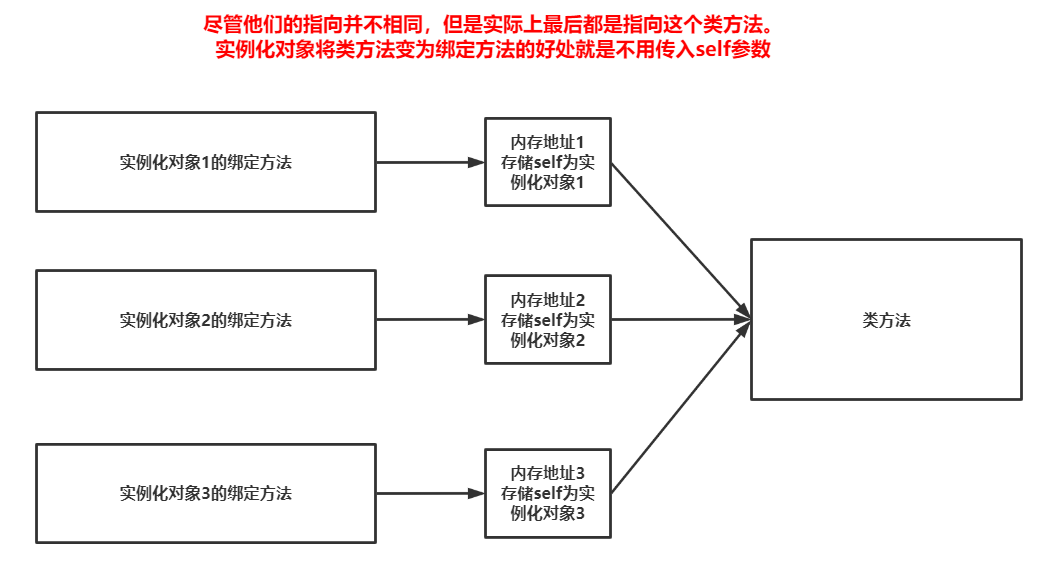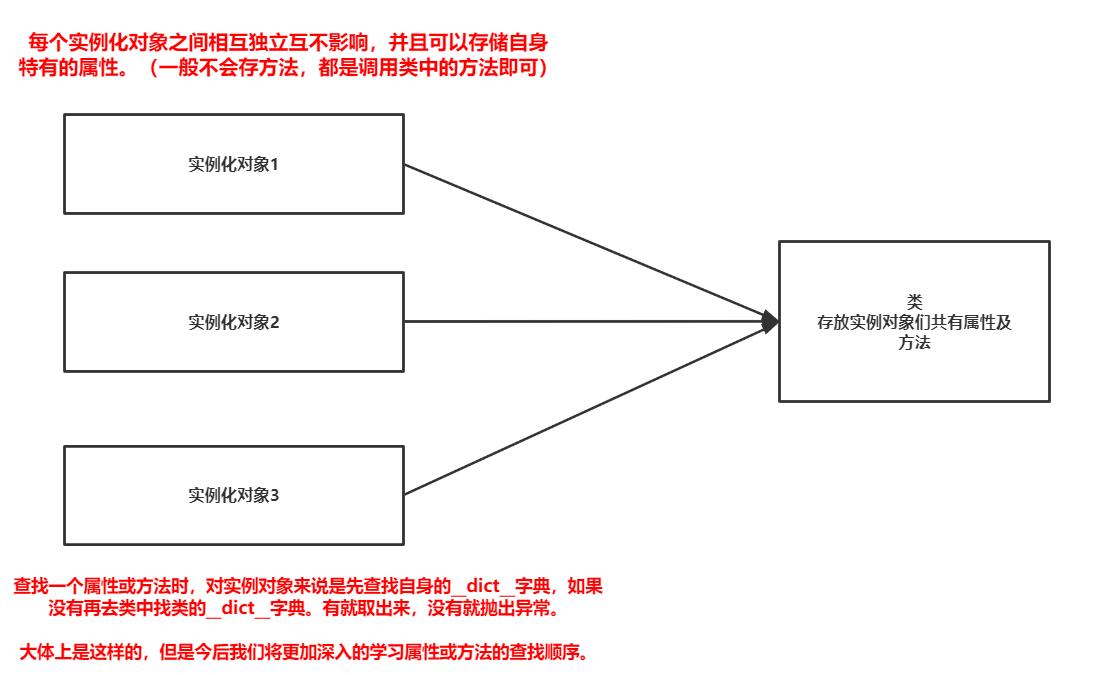Python初识类与对象
类与对象
世界观角度分析类与对象
类是一个抽象的概念,而对象是一个实体的存在,对象由类创造而出,每个对象之间互相独立互不影响,一个对象可以同时拥有多个类的方法,实例化就是通过某类创建对象的过程。
比如,某一个人是一个具体的对象,而人类则是人这个对象的来源,人类是一个抽象的概念并且人类又属于哺乳类,所以人也应该具有哺乳类的方法和行为(继承),每个人具有不同的样貌,声音及其自身的不同习惯(多态)。一只猴子不属于人类,因为他没有人类共有的属性和方法,比如:人没有尾巴,人会说话 等等。(封装)。
程序功能角度分析类与对象
从程序功能角度来看,类是其对象存放共有方法以及属性的地方。并不存在什么抽象不抽象,我一样可以用类来做很多事情。对象确实是由类产生的但是类也是一个对象,因为类它的确可以存放属性以及方法。
类与对象的关系就在于,类可以存放其实例化对象所需要用到的公共方法与属性,而实例化对象则可以具有类对象不具有的某些属性或方法。
类的定义
定义类发生的几件事:
1.申请内存空间保存类体代码
2.将上述内存地址绑定给类名
3.创建类专属的局部命名空间(注意与函数区分。函数是在执行阶段才会做这件事)
4.执行类体代码(注意与函数区分。函数的定义阶段不会执行其内部代码)

类的实例化
实例化类发生的几件事情:
1.调用执行类下的
__new__()方法进行类的实例化2.调用执行类下的
__init__()方法进行实例对象的构造3.创建实例对象独有的命名空间
class People(object): # <-- 类名:驼峰体, (继承类),可以写也可以不写,推荐写上。 """这是人类""" # <-- 说明 number_of_eyes = 2 # 眼睛数量 number_of_mouths = 1 # 嘴巴数量 number_of_ears = 2 # 耳朵数量 number_of_noses = 1 # 鼻子数量 def __init__(self, name, color, height, weight): # 方法/功能 self.name = name # self ---> 实例化对象 self.color = color self.height = height self.weight = weight def speak(self, content): # 方法/功能 print("{0}说:{1}".format(self.name, content)) # ==== 实例化对象 ==== Ps:可以看到实例化出的对象内存地址完全不同。并且他们还具备了类本身不具备的某些属性,这些属性被称为实例属性 p1 = People("云崖", "黄色", 192, 158) print(p1) # <__main__.People object at 0x00000183AECE3E80> print(id(p1)) # 1665085095552 print(type(p1)) # <class '__main__.People'> p2 = People("二狗", "黑色", 145, 148) print(p2) # <__main__.People object at 0x00000183AED502B0> print(id(p2)) # 1665085538992 print(type(p2)) # <class '__main__.People'> # ==== 执行结果 === Ps:可以看到并没有使用()调用类 """ 执行了... """
__dict__方法
类:可以查看到当前类下所有的类属性以及类方法
实例对象:可以查看到当前实例对象下所有的实例属性以及实例绑定方法
class People(object): # <-- 类名:驼峰体, (继承类),可以写也可以不写,推荐写上。 """这是人类""" # <-- 说明 number_of_eyes = 2 # 眼睛数量 number_of_mouths = 1 # 嘴巴数量 number_of_ears = 2 # 耳朵数量 number_of_noses = 1 # 鼻子数量 def __init__(self, name, color, height, weight): # 方法/功能 self.name = name # self ---> 实例化对象 self.color = color self.height = height self.weight = weight def speak(self, content): # 方法/功能 print("{0}说:{1}".format(self.name, content)) # ==== 查看类字典 ==== print(People.__dict__) # ==== 查看实例字典 ==== p1 = People("云崖", "黄色", 192, 158) print(p1.__dict__) # {'name': '云崖', 'color': '黄色', 'height': 192, 'weight': 158} # ==== 执行结果 === Ps: 可以看到类字典中具有类所有的属性及方法,而实例字典中只有实例自己的实例属性。(当然你也可以为其添加实例方法) """ {'__module__': '__main__', '__doc__': '这是人类', 'number_of_eyes': 2, 'number_of_mouths': 1, 'number_of_ears': 2, 'number_of_noses': 1, '__init__': <function People.__init__ at 0x000001B8650DFF70>, 'speak': <function People.speak at 0x000001B86D4B9700>, '__dict__': <attribute '__dict__' of 'People' objects>, '__weakref__': <attribute '__weakref__' of 'People' objects>} {'name': '云崖', 'color': '黄色', 'height': 192, 'weight': 158} """
类属性与实例属性的增删改查
无论是对实例化属性/方法,或者是对类属性/方法进行增删改查,实际上都是非常单纯的对
__dict__进行操作。类属性的增删改查:会影响所有实例化对象。
实例属性的增删改查:只会影响当前实例化对象,不会影响其他实例化对象以及类。
注意:一般不会对实例新增某个单独的方法,没有这种玩法...而且除开元类编程,类方法的定义也不会放在外部。所以这里只是针对类属性或实例属性的增删改查

class People(object): # <-- 类名:驼峰体, (继承类),可以写也可以不写,推荐写上。 """这是人类""" # <-- 说明 number_of_eyes = 2 # 眼睛数量 number_of_mouths = 1 # 嘴巴数量 number_of_ears = 2 # 耳朵数量 number_of_noses = 1 # 鼻子数量 def __init__(self, name, color, height, weight): # 方法/功能 self.name = name # self ---> 实例化对象 self.color = color self.height = height self.weight = weight def speak(self, content): # 方法/功能 print("{0}说:{1}".format(self.name, content)) # ==== 实例化对象 ==== p1 = People("云崖", "黄色", 192, 158) p2 = People("二黑", "黑色", 155, 148) # ==== 类属性属性的增 ==== People.number_of_leg = 2 # 腿的数量 相当于 People.__dict__["number_of_leg"] = 2 # ==== 类属性、方法的删 ==== del People.number_of_eyes # 解除属性名number_of_eyes与其堆内存存储值的绑定关系 相当于 del People.__dict__["number_of_eyes"] del People.speak # 解除方法名speak与类方法内存空间的绑定关系 相当于 del People.__dict__["speak"] # === 类属性的改 ==== People.number_of_mouths = "一" # 相当于 People.__dict__["number_of_mouths"] = "一" # === 类属性的查 ==== print(People.number_of_leg) # 2 print(People.number_of_mouths) # 一 # === 类的属性增删改查对实例的影响 === 总结:类属性任何增删改查都会影响其实例化对象 print(p1.number_of_mouths) # 一 print(p2.number_of_mouths) # 一

class People(object): # <-- 类名:驼峰体, (继承类),可以写也可以不写,推荐写上。 """这是人类""" # <-- 说明 number_of_eyes = 2 # 眼睛数量 number_of_mouths = 1 # 嘴巴数量 number_of_ears = 2 # 耳朵数量 number_of_noses = 1 # 鼻子数量 def __init__(self, name, color, height, weight): # 方法/功能 self.name = name # self ---> 实例化对象 self.color = color self.height = height self.weight = weight def speak(self, content): # 方法/功能 print("{0}说:{1}".format(self.name, content)) # ==== 实例化对象 ==== p1 = People("云崖", "黄色", 192, 158) p2 = People("二黑", "黑色", 155, 148) # ==== 实例化对象属性的增 ==== p1.number_of_leg = 2 # 腿的数量 相当于 p1.__dict__["number_of_leg"] = 2 p1.p1_del_val = "将要删除的值" # 相当于 p1.__dict__[p1_del_val] = "将要删除的值" # ==== 实例化对象属性的删 ==== del p1.p1_del_val # === 实例化对象属性的改 ==== p1.number_of_mouths = "一" # 相当于 p1.__dict__["number_of_mouths"] = "一" # === 实例化对象属性的查 ==== print(p1.number_of_leg) # 2 print(p1.number_of_mouths) # 一 # === 实例化对象的属性增删改查对其他实例化对象及类的影响 === 总结:实例化对象对于属性增删改查只影响自己,并不影响其他实例化对象,更不会影响类本身。 # -- 类,与其他实例化对象没有下面两个属性 -- # print(p2.number_of_leg) # print(People.number_of_leg) print(p1.number_of_mouths) # 一 print(People.number_of_mouths) # 1 print(p2.number_of_mouths) # 1 # Ps: 也可以用 实例对象名称[属性名称]来进行操作。
__init__方法与self参数
__init__方法:是实例化对象时所自动调用的方法。必须返回一个None,否则抛出异常,通常我们用它来构造实例化对象特有的一些属性。
self参数:在__init__方法中应当是一个即将被实例化的空对象,下面的self.xxx = yyy其实都是在为这个空对象中的变量名进行赋值操作。而在其他方法中,self参数指的是已经实例化好的对象本身。
前面说过,类是存放实例化对象中一些共有的方法与属性的,这些共用的方法和属性称之为类方法、类属性。那么我们肯定是允许每一个实例化对象拥有自己一些差异化的内容,这些差异化内容的传递其中最简便的方法就是使用Python为我们提供的 __init__ 方法。
def __init__(self, name, color, height, weight): # 方法/功能 self.name = name # self ---> 实例化对象 self.color = color self.height = height self.weight = weight
class TestInit(object): def __init__(self): print(self) # 此时产生一个空对象 print(self.__dict__) # {} self.x = "任意值" print(self.__dict__) def testobj(self): print(self.__dict__) t1 = TestInit() # 这一步实际上是将生产的对象self赋值给了t1 print(t1) print(t1.__dict__) # === self的常规玩法 === t1.testobj() # 我们的实例对象在调用该方法时,会将自身传入进去 # === self的其他玩法 === 当使用类调用某类方法时,我们只需要为其传入一个对象对应上self参数即可。 TestInit.testobj(t1) # 和上面均属于相同的操作。 t2 = TestInit() t2.__dict__ = {"t2专属__dict__": None} TestInit.testobj(t2) # ==== 执行结果 ==== """ <__main__.TestInit object at 0x000001A1FF763E80> {} {'x': '任意值'} <__main__.TestInit object at 0x000001A1FF763E80> {'x': '任意值'} {'x': '任意值'} {'x': '任意值'} <__main__.TestInit object at 0x000001A1FF7D02B0> {} {'x': '任意值'} {'t2专属__dict__': None} """
实例化的绑定方法
当实例化一个类对象的过程中,类方法会变为该实例化对象的绑定方法。绑定方法的作用在于不用传入
self参数,而是自动传入self参数为当前的实例化对象。Ps:当使用类调用需要传入
self的类方法时,必须手动将对象传入self中。注意区分,实例绑定方法与类中的方法。
# class People(object): # <-- 类名:驼峰体, (继承类),可以写也可以不写,推荐写上。 """这是人类""" # <-- 说明 number_of_eyes = 2 # 眼睛数量 number_of_mouths = 1 # 嘴巴数量 number_of_ears = 2 # 耳朵数量 number_of_noses = 1 # 鼻子数量 def __init__(self, name, color, height, weight): # 方法/功能 self.name = name # self ---> 实例化对象 self.color = color self.height = height self.weight = weight def speak(self, content): # 方法/功能 print("{0}说:{1}".format(self.name, content)) # ==== 实例化对象 ==== p1 = People("云崖", "黄色", 192, 158) # ==== 查看类方法 ==== print(People.speak) # <function People.speak at 0x0000024EE94A8700> # ==== 查看绑定方法 ==== print(p1.speak) # <bound method People.speak of <__main__.People object at 0x000001C6D32B3E80>> bound method 绑定方法

类与实例对象的命名空间作用域及属性查找顺序



